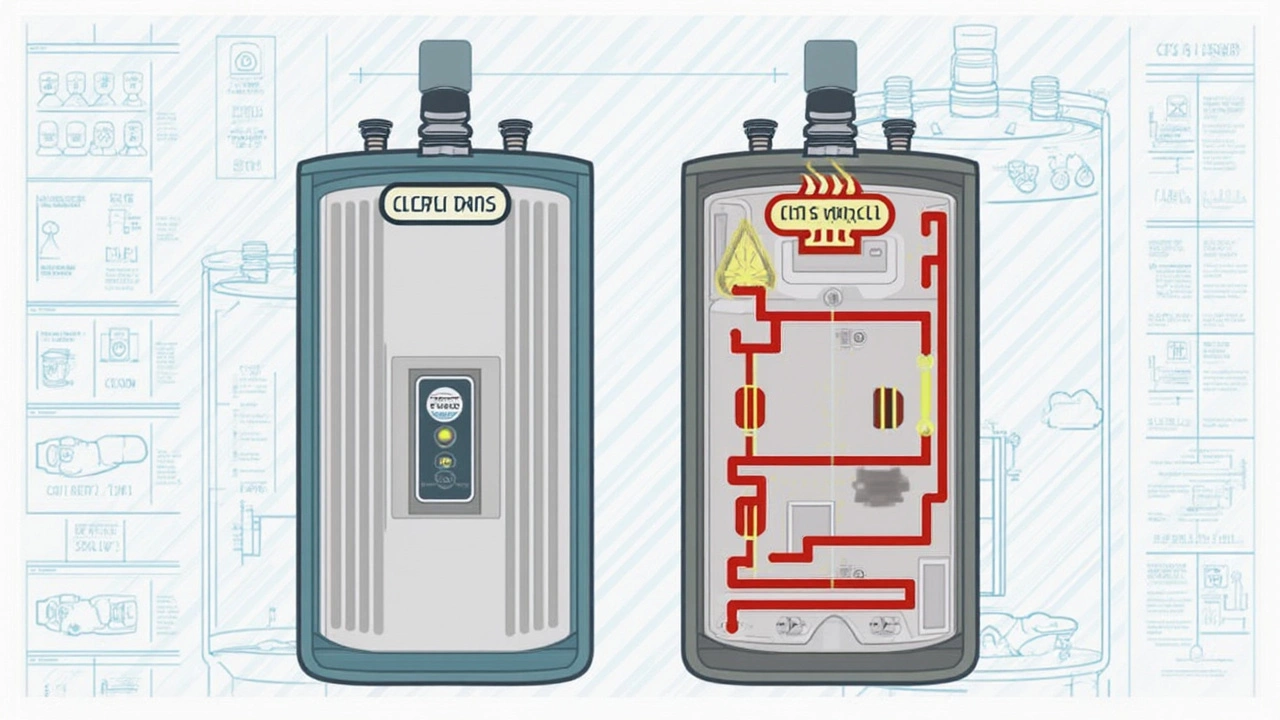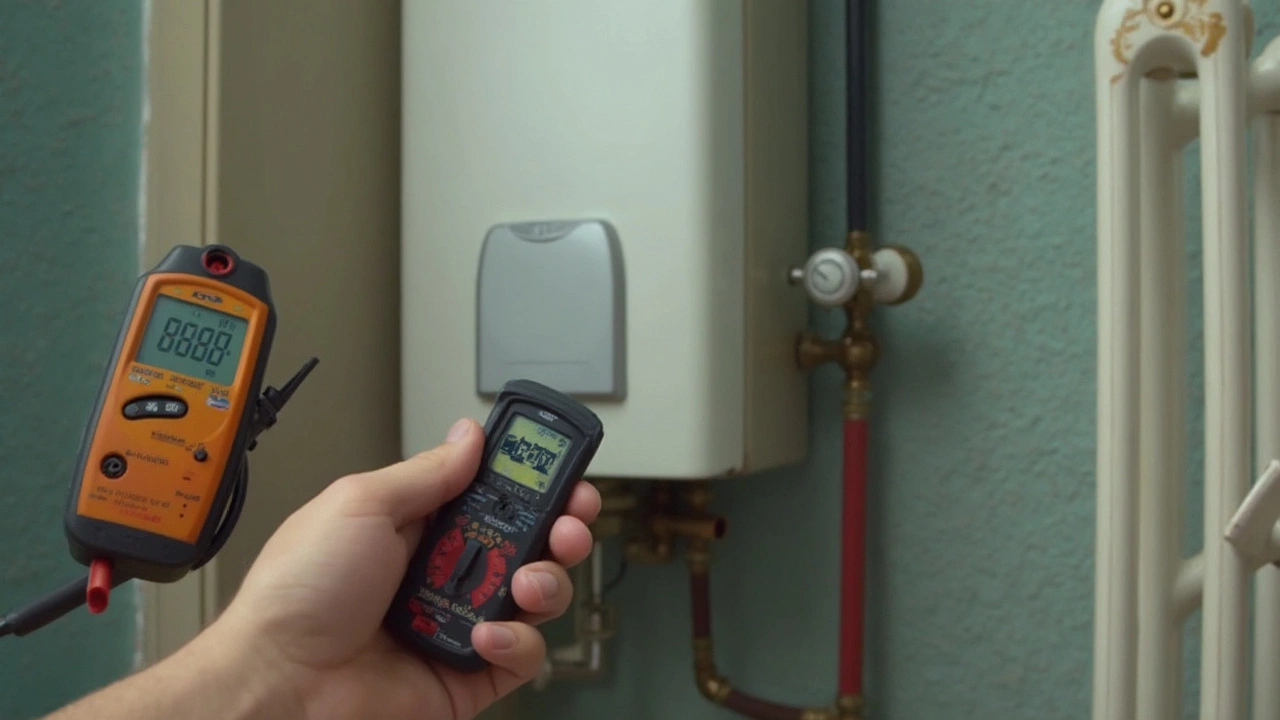Ever step into the shower expecting warmth and suddenly get hit with freezing water? That jolt might mean your water heater thermostat is acting up. No one wants icy surprise showers or sky-high energy bills—and a bad thermostat can cause both.
Most folks don’t think about their water heater until it acts weird. Maybe the water’s way too hot, or there’s barely any hot water at all. That’s usually your first clue that the thermostat could be failing. Here's the thing: you don’t need to be a pro to figure out if your thermostat’s the problem. There are a few common signs you can catch early, saving you from bigger headaches (and costs!) down the line.
- Spotting the Early Warning Signs
- How Water Heater Thermostats Work
- Simple Home Tests Anyone Can Do
- Common Causes of Thermostat Failure
- When to Repair vs. Replace
Spotting the Early Warning Signs
Knowing what to look for saves you time and money. If your hot water isn't acting right, chances are good your water heater thermostat could be the problem. Here’s what you want to watch for:
- Water temperature swings. If your shower goes hot-cold-hot in seconds, or your kitchen tap just can't make up its mind, this might be an early sign.
- Water always cold or always scalding. If no matter how long you wait, the water stays cold, your thermostat might not be turning on the heating element. On the flip side, if it's always dangerously hot, your thermostat could be stuck "on."
- Heater keeps tripping the reset button. That little red reset button on your electric water heater popping out again and again? It's often a sign that the thermostat is letting things overheat.
- Short supply of hot water. If you used to get a full shower and now run out halfway, one of the two thermostats (upper or lower) in a dual-element heater could be toast.
- Unusual noises. Clicking or popping from your water heater isn’t always thermostat-related, but it sometimes points to the controls cycling on and off too often.
If you notice these signs, don’t ignore them. According to data from the National Appliance Energy Conservation Act, up to 30% of electric water heater failures each year are linked to thermostat problems—not just old age.
| Symptom | Possible Thermostat Issue? |
|---|---|
| Tepid or cold water | Yes, thermostat stuck off |
| Scalding hot water | Yes, thermostat stuck on |
| Water heater trips breaker | Often, due to faulty thermostat |
| Heat doesn’t last | Sometimes, lower element thermostat issue |
Diagnosing these symptoms early is key to preventing bigger problems, like blown heating elements or even leaks from overheated water. I always tell folks, if hot water changes suddenly, don’t just assume your tank is dying—start by checking that thermostat first.
How Water Heater Thermostats Work
If you want hot showers on demand, your water heater thermostat has to be working right. So what does it actually do? The water heater thermostat sits on the tank and keeps track of how hot the water gets. It acts like your home’s traffic cop, switching the heater on or off depending on the temperature inside the tank.
With an electric water heater, you probably have two thermostats—one up top, another down below. The upper thermostat starts first. When the water at the top is hot enough, it lets the lower one heat up the bottom. This way, you don’t end up with pockets of cold water, especially if you’ve got a bigger tank.
In gas water heaters, there’s just one main thermostat—usually part of the gas control valve and located towards the bottom of the tank. When it senses water cooling down, it tells the burner to fire up and heat things back up. Simple, but super important for safe, steady hot water.
If you’re curious about typical temperature settings, most thermostats keep water between 120°F and 140°F (lots of plumbers say 120°F is the sweet spot for safety and savings). Here’s a quick snapshot of common stats:
| Heater Type | # of Thermostats | Typical Set Temp |
|---|---|---|
| Electric | 2 | 120°F – 140°F |
| Gas | 1 | 120°F – 140°F |
Basically, if your water heater thermostat is off, you’ll notice—either everything goes cold, or the water gets hotter than it should (not great when kids like Rowan need a safe bath). That’s why knowing how yours works helps you spot problems fast.

Simple Home Tests Anyone Can Do
Before you jump to call in the big guns, there are easy ways to check if your water heater thermostat is bad. No special skills needed—just a bit of caution and a screwdriver can get you answers faster than waiting for a plumber.
First things first: safety always comes first. Turn off the power at the breaker (for electric heaters) or set your gas heater to 'pilot' so you don’t risk a shock or a burn. Only once it’s off, you’re good to pop off the access panels.
- Feel the Water: Run hot water at a tap for a minute. Is it lukewarm, scorching, or just cold? If it’s all over the place, your thermostat could be the problem, especially if your heater is working but the temps are wild.
- Look for the Reset Button: Some electric water heaters have a red reset button near the thermostat. If it’s popped out, press it back in. If it WON’T stay in, or it keeps popping out, the thermostat might be toast.
- Check the Temperature Setting: Sometimes, someone just bumped it! Set the thermostat to about 120°F (49°C). Anything higher can be risky, especially if kids (like Rowan) use the hot water. Wait a while, then see if the water heats to match the setting. If it never gets close, you might have found your culprit.
- Multimeter Magic: If you own a cheap multimeter, put it to work. With the power still OFF, remove the thermostat cover. Test the terminals for continuity. No continuity? That’s a sure sign the thermostat is bad. Always double-check the power is off—it’s not worth the zap.
- Compare Upper and Lower Elements (For Electric Heaters): Electric units usually have two thermostats—one up top and one below. If only part of your tank heats, it might be the lower thermostat or element. Switch the wires between them briefly (with power OFF). If the problem shifts to the other section, you’ve nailed the part that’s busted.
Here’s a quick cheat sheet to keep you on track:
| Test | What to Look For | What It Means |
|---|---|---|
| Reset button pops out | Repeated tripping | Bad thermostat or overheating |
| Water temp mismatch | Doesn’t match dial | Thermostat likely faulty |
| No continuity (multimeter) | No beep/reading | Replace the thermostat |
| Hot water inconsistencies | Top vs. bottom differences | One thermostat or element out |
These simple steps can save you time and money. Most of the time, if your water heater thermostat is the issue, you’ll spot it pretty quick this way. If nothing adds up, or if you’re ever unsure, it’s smart to call a pro before things get worse.
Common Causes of Thermostat Failure
Most problems with your water heater thermostat come down to a few key reasons. Understanding these can help you decide what to do next—and maybe even spot trouble before things break for good. Let's talk through the main offenders.
- Wear and tear: Thermostats don’t last forever. After years of switching on and off, the internal parts just wear out. If your heater is over 8-10 years old, breakdown is way more likely.
- Electrical issues: Loose wiring, corroded connections, or just plain old power surges can fry a thermostat. If you’ve had power outages or flickering lights in the house, your thermostat could’ve taken a hit, too.
- Moisture buildup: Leaks inside your water heater or humidity in your basement wreck electronics. Water and electricity don’t mix, and sometimes water seeps into the thermostat’s housing, shorting it out.
- Bad heating elements: Here’s a sneaky one—a failed heating element can make it seem like your thermostat is the problem. But sometimes, the thermostat keeps working to heat your water, and the element just won’t cooperate.
- Manufacturing defects: Even the best brands let a dud slip by sometimes. If your water heater thermostat fails early, it could be a flaw in the unit itself.
Want a quick look at how often these problems show up? Here’s what some repair shops see:
| Cause | % of Failures |
|---|---|
| Wear and Tear | 45% |
| Electrical Issues | 30% |
| Moisture or Leaks | 15% |
| Heating Element Mix-up | 8% |
| Factory Defect | 2% |
So yeah—most of the time, it's just age or some random short. You’ll save yourself a ton of guesswork (and maybe cash) by knowing these main causes whenever you have to diagnose a bad thermostat in your water heater.

When to Repair vs. Replace
So, you know something’s up with your water heater thermostat. The big question: should you try to fix it or bite the bullet and get a new one? Here’s how to make that call without getting ripped off or wasting time.
If your water heater is under ten years old and has been running fine until now, a simple thermostat replacement usually does the trick. Thermostats are pretty cheap (usually $20-$40 for most electric models), and it’s a repair most homeowners can handle with the right safety steps. Most gas water heaters can get by with a replacement thermostat, but you’ll want to double-check your particular model since parts and procedures vary.
Trouble is, thermostats are sometimes just the “face” of a bigger problem. If your tank is older than ten years, leaks, shows rust, or has a weird burning smell, that points to more serious issues. At that point, the smart move is replacing the whole water heater instead of just the bad thermostat. Installing a new unit can actually save you money on energy bills and reduce surprise breakdowns.
- Repair it: Only the water temperature is off, there’s no sign of leaks, heater is under 10 years old, and your energy bill hasn’t jumped.
- Replace the heater: The water tank is rusty, leaking, older than 10 years, or you keep having to fix it every few months.
Here’s a quick look at typical costs, so you know what to expect:
| Service | Expected Cost (USD, 2025) |
|---|---|
| Thermostat Replacement | $20–$50 (part) + $100–$200 (labor, if not DIY) |
| New Standard Water Heater | $500–$1,200 (installed) |
Don’t forget: safety first. If you smell gas, see water puddling, or hear popping sounds from your heater, shut it down and call a pro. Sometimes what looks like a bad thermostat can be something a lot riskier.


